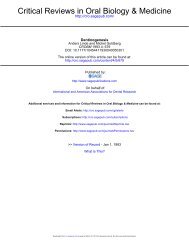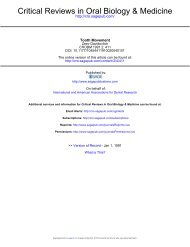Autogenous and Allogeneic Bone Grafts in Periodontal Therapy
Autogenous and Allogeneic Bone Grafts in Periodontal Therapy
Autogenous and Allogeneic Bone Grafts in Periodontal Therapy
You also want an ePaper? Increase the reach of your titles
YUMPU automatically turns print PDFs into web optimized ePapers that Google loves.
Critical Reviews <strong>in</strong> Oral Biology <strong>and</strong> Medic<strong>in</strong>e, 3(4):333-352 (1992)<br />
<strong>Autogenous</strong> <strong>and</strong> <strong>Allogeneic</strong> <strong>Bone</strong> <strong>Grafts</strong> <strong>in</strong><br />
<strong>Periodontal</strong> <strong>Therapy</strong><br />
James T. Mellonig, D.D.S., M.S.<br />
Department of Periodontics, The University of Texas, Health Science Center, San Antonio, TX 78284<br />
ABSTRACT: This article is limited to a review of bone autografts <strong>and</strong> allografts, as used <strong>in</strong> periodontal therapy.<br />
The various graft materials are discussed with respect to case reports, controlled cl<strong>in</strong>ical trials, <strong>and</strong> human<br />
histology. Other reviewed areas are wound heal<strong>in</strong>g with periodontal bone grafts, tissue bank<strong>in</strong>g <strong>and</strong> freeze-dried<br />
bone allografts, <strong>and</strong> the use of bone grafts <strong>in</strong> guided tissue regeneration.<br />
KEY WORDS: <strong>Periodontal</strong>, bone autograft, bone allograft, tissue bank<strong>in</strong>g, guided tissue regeneration.<br />
I. INTRODUCTION<br />
Bacterially <strong>in</strong>duced periodontitis leads to the<br />
destruction of tooth-support<strong>in</strong>g tissues, culm<strong>in</strong>at<strong>in</strong>g<br />
<strong>in</strong> tooth loss. Disease reversal with regeneration<br />
of new bone, cementum, <strong>and</strong> periodontal<br />
ligament about a root surface previously<br />
contam<strong>in</strong>ated by bacterial plaque is the ultimate<br />
goal of periodontal therapy.<br />
<strong>Bone</strong> grafts, both autogenous <strong>and</strong> allogeneic,<br />
are felt by some to be essential if restoration of<br />
lost bone accompanied by a functional attachment<br />
apparatus is to be achieved. "<strong>Bone</strong> graft<strong>in</strong>g<br />
materials will enhance regeneration of a new attachment<br />
apparatus" (Bowers et aL, 1989c).<br />
"Osseous graft<strong>in</strong>g therapy has been shown to be<br />
cl<strong>in</strong>ically successful for time <strong>in</strong>tervals exceed<strong>in</strong>g<br />
20 years when encompassed <strong>in</strong> a comprehensive<br />
care program based on effective daily plaque control<br />
by the patient <strong>and</strong> a professionally supervised<br />
periodontal ma<strong>in</strong>tenance program" (Schallhorn,<br />
1980).<br />
Others believe that the use of bone grafts to<br />
enhance regeneration of the periodontium is unacceptable.<br />
' 'Not one of the human implant studies<br />
has provided the type of experimental model<br />
that clearly demonstrates new attachment for-<br />
1045-4411/92/$.50<br />
© 1992 by CRC Press, Inc.<br />
mation. Many of the <strong>in</strong>vestigators have failed to<br />
provide controls, <strong>and</strong> none have provided the<br />
unequivocal histologic evidence of new attachment<br />
to previously diseased roots" (Gara <strong>and</strong><br />
Adams, 1981). "From the st<strong>and</strong>po<strong>in</strong>t of scientific<br />
documentation, the value (of regenerative<br />
procedures) is not clear. Spectacular results of<br />
"bone fill" <strong>in</strong> <strong>in</strong>trabony pockets have been reported<br />
with or without bone implantation"<br />
(Ramfjord, 1984).<br />
Still others are conv<strong>in</strong>ced that bone grafts are<br />
detrimental. "Ignorance of the contribution of<br />
the various tissue components <strong>in</strong> periodontal<br />
wound heal<strong>in</strong>g may expla<strong>in</strong> the widespread use<br />
of bone transplants <strong>in</strong> the treatment of <strong>in</strong>trabony<br />
pockets" (Kar<strong>in</strong>g et aL, 1984). "S<strong>in</strong>ce granulation<br />
tissue derived from bone has the potential<br />
to <strong>in</strong>duce root resorption <strong>and</strong> ankylosis, the rationale<br />
of favor<strong>in</strong>g bone growth with the use of<br />
bone transplants is highly questionable" (Karr<strong>in</strong>g<br />
etaL, 1980).<br />
Cl<strong>in</strong>ical case reports, controlled cl<strong>in</strong>ical trials,<br />
<strong>and</strong> human histology document<strong>in</strong>g the results with<br />
bone grafts have been reviewed previously (Pfeifer,<br />
1969; Groff, 1976a <strong>and</strong> b; Ellegaard, 1976;<br />
Schallhorn, 1977; Schallhorn, 1980; Mellonig,<br />
1980; Wirthl<strong>in</strong>, 1981; Gara <strong>and</strong> Adams, 1981;<br />
Downloaded from<br />
cro.sagepub.com by guest on January 10, 2013 For personal use only. No other uses without permission.<br />
333




